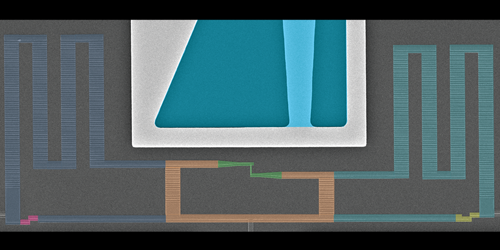Fluxonium Qubits Under Control
The leading technology for quantum computers is based on superconducting qubits called transmons. Ease of fabrication has been a key advantage of transmons over their main superconducting competitors, fluxonium qubits, which consist of loops of many nanoscale Josephson junctions. Recent advances in nanofabrication have made fluxonium qubits easier to engineer, however, triggering a new wave of interest in this architecture (see Viewpoint: Fluxonium Steps up to the Plate). Now University of Chicago physicists Helin Zhang and Chunyang Ding and their collaborators have realized a tunable interaction between two fluxonium qubits, which allowed them to demonstrate a two-qubit gate with a fidelity (a reliability metric for a quantum device) exceeding 99.9% [1]. The result is an important step toward building large-scale fluxonium-based quantum computers, the researchers say.
A fluxonium qubit encodes information in the current flowing in the loop of Josephson junctions. Typically, interactions that couple adjacent qubits are mediated by electric fields generated by capacitors integrated into the circuit. Zhang, Ding, and colleagues instead used an inductive coupler consisting of a smaller loop of Josephson junctions placed between two qubits. The strength of the inductive coupling—an order of magnitude larger than that of capacitive coupling—made this architecture capable of two-gate operations with a fidelity rivaling that of any other superconducting qubit technology. The team also demonstrated that the coupling could be turned off with a microwave signal, allowing independent control of each of the qubits.
Ding says that the Josephson-junction-based coupler demands close proximity between the qubits, causing unwanted crosstalk that would make it hard to scale up the architecture to large numbers of qubits. But the proximity requirements could be loosened with alternative inductive-coupling approaches, he says.
–Marric Stephens
Marric Stephens is a Corresponding Editor for Physics Magazine based in Bristol, UK.
References
- H. Zhang et al., “Tunable inductive coupler for high-fidelity gates between fluxonium qubits,” PRX Quantum 5, 020326 (2024).




